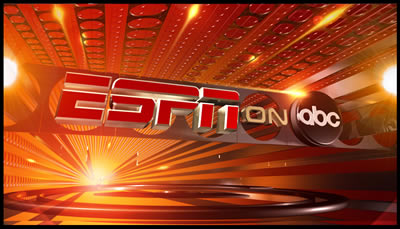Reading ESPN Against Niches
By Sudeep Sharma
In August 2006, The New York Times ran an obituary for ABC Sports.1 The article, “ABC Sports Dead at 45, Stand by for ESPN,” mourned the loss of the haloed network division that was home to the ''Wide World of Sports,'' Howard Cosell, and Roone Arledge. The sorrow of this death was deepened by the new title that would now accompany all sports broadcasting on ABC: “ESPN on ABC.”

The change in branding was, in a way, a triumph from the subjugation of a genre of programming as part of a network (ABC Sports) to the genre’s domination over a network (ESPN on ABC). While symbolizing the drastic changes that sports media have gone through in the last thirty years, describing the change in corporate nomenclature as a death misses the larger point for media scholarship.
During the network era, sports on television were mostly a weekend occurrence. It consisted of several nationally televised regular season games per year, major events like championships, the Super Bowl, and the Olympics, some selected one-off coverage, like track and field, and that was about it. Today, sports television is a 24/7, 365 days a year occurrence, and a billion dollar enterprise with millions of viewers. Not only professional (read commercial) sports and college athletics of all kinds, but events like the National Spelling Bee and tournament poker get wall-to-wall coverage on television, print, and now, increasingly, the internet. I would like to suggest that sports media, especially in regards to television, has become so big and such a reliable source of content and revenue for many media conglomerates that we need to learn more about it specifically. Instead of seeing sports television as a mere genre or niche programming, by seeing sports on television as just television we can gain important insight into how vertically integrated media conglomerates reach all media consumers. The continuous nature of sports media encourages media consumption beyond sports in two important ways: creating a marketing access point for other non-sports media products and developing narratives that go beyond the immediate coverage of athletic events. A look at ESPN exemplifies both of these strategies.
When ESPN first aired in 1979, the dominant view of the three major networks was that a few hours of sports programming was all the American public wanted and, more importantly, needed. Today, ESPN is a behemoth. Broadcasting both actual games and original programming including its ubiquitous highlight show SportsCenter, ESPN is spread across multiple platforms that expand its brand identity into nearly every media form available. Beyond the networks of ESPN, ESPN2, ESPN News (a kind of Headline News for sports), and ESPN Classic, there is ESPN.com, ESPN the magazine (with a separate website), ESPN Deportes, ESPN Books, ESPN original television production, ESPN MVP (ESPN’s cell phone content network), and ESPN Films. ESPN reported ESPN and ESPN2 reach some 97 million households, and as many as 93.7 million people a month watch SportsCenter, its premier program.2

Like other commercial cable networks, ESPN has followed a similar pattern of quixotic entrepreneurial beginnings to increased viewership and mergers with larger media conglomerates. ESPN became part of Capital Cities/ABC in 1984, with Disney eventually buying the merged company for $19 billion in 1996. Then Disney chairman Michael Eisner called ESPN the “crown jewel” of the purchase mostly due to the synergetic possibilities the network provided for Disney in the advertising of its many subsidiaries’ products.3 For example, soon after the purchase in 1996, Whoopi Goldberg sat in as a guest host for a segment on SportsCenter. Goldberg was on air to promote her starring role in Eddie, a film about a limo driver/fan who becomes the coach of the New York Knicks, which was produced by Hollywood Pictures, a subsidiary of Disney.
This kind of cross-promotion within the Disney/ABC/ESPN conglomerate has become more blatant over the years and often blurs the distinction between sports and more traditional narrative entertainment. The relationship and eventual marriage of Eva Longoria and San Antonio Spurs’ guard Tony Parker is often framed in a way that markets the NBA on ESPN and Desperate Housewives on ABC. Eva Longoria is not only frequently shown cheering her husband at Spurs games throughout the season and the playoffs, but also with other Desperate Housewives stars in accompanying promotional material for the NBA on ABC. During the Spurs celebrations after winning in the Finals in 2007, Longoria (unlike other player wives) was interviewed along with Parker’s teammates.
Although the involvement and focus on athlete’s significant others is not new, the level, intensity and conflicted nature of time spent promoting Longoria (and indirectly ABC’s Desperate Housewives) speaks to the complicated and at times seamless integration of ESPN’s sports reporting and promotion of other corporate products.
Examples of cross promotion between ESPN and the larger Disney umbrella are legion and fairly obvious such as the Jonas Brothers’ June 2009 appearance on SportsCenter:
What is more important in terms of production for media scholars is the creation of narratives that can control ESPN’s coverage across platforms for a day, month or year. The narratives that rise out of sports competition are definitely numerous, but they come with a high level of unpredictability. Who will win or lose and what this means is often difficult to predict and depends on a great deal of time sensitive labor. By the next day everything can change and the special made to mark the perfect 19-0 Patriots season becomes worthless. By creating its own narratives, ESPN can regularize its programming schedule and operating practices. For example, two years ago ESPN produced two on-going series, Who’s Now? and The Ultimate Highlight. Both were context-less, tournament style competitions pitting athletes or highlights against each other, existing as individual shows and integrated as segments on SportsCenter. On-air personalities debate issues that aren’t naturally occurring (“Who’s more now? Tiger Woods or Lebron James?”), and through ESPN.com and ESPN MVP, viewers can vote or generally contribute to the discussion. A more recent example of this is the “Mt. Rushmore of Sports” series of short SportsCenter segments hosted by Rick Reilly that attempts to pick the “greats” of sports from each US state to be enshrined in monumental sculpture.4
An even more involved and remarkable creation of narrative by ESPN was in retired NBA player John Amaechi’s public announcement in his memoir Man in the Middle that he is gay, becoming the first NBA player ever to come out.5 ESPN Books, ESPN’s publishing company, published the book. Unlike other sports events it covers, like a win, loss, trade or firing, Amaechi’s announcement could be controlled directly by ESPN’s marketing operation. February, the month the Amaechi story “broke,” has historically been a down month for US sports. Football is over, baseball is another month from spring training, basketball is in its dog days, and college basketball is a month away from March madness. Amaechi’s announcement was perfectly timed to fill a gap in coverage for ESPN (much like Who’s Now and the Mt. Rushmore series that also originally aired in February). The week of its release Amaechi and the issue of homosexuality in sports dominated ESPN and other media outlets’ overall coverage.6 The coverage though did not actually advance the story of homosexuality in sports and instead mostly focused on the most hateful, bigoted response from a former player, Tim Hardaway (which happened to occur during an interview on ESPN radio).7 The focus on Hardaway’s response made Amaechi’s announcement a more adversarial and controversial story. From ESPN books, to ESPN television, to radio, to the .com, to the magazine, a narrative was conceived, developed and reported on all under the same brand.8
Sound familiar? Cross network synergetic promotion and the creation of narratives that develop on multiple platforms have become hallmarks of the massive conglomerates that provide media content to millions. Critical media research is missing out on rich and contemporarily relevant material by placing sports in a subcategory or considering it as a “lesser than” media form. In an article announcing ESPN expansion into feature films, Keith Clinkscales, ESPN’s senior vice president for content development is quoted as saying, “A lot of people who spend time being engaged in ESPN also spend a lot of time going to the movies.” In other words, those who consume sports also consume media – sports viewers are viewers. In that spirit, I would like to suggest we see ESPN and its goals as a company as not limited to a niche demographic, but instead consider it as a contemporary example of a vertically integrated media conglomerate attempting to reach all media consumers. With their enormous numbers of viewers, interesting programming decisions, and specifically created narratives, ESPN must be seriously considered by media scholars in order to provide meaningful insight into the contemporary mediascape. Otherwise, we’ll be writing and reading obituaries for corporate divisions like ABC Sports, and missing the forest for the trees.
NOTES
- Richard Sandomir. “TV Sports; ABC Sports is Dead at 45; Stand By for ESPN.” The New York Times. 11 August 2006. http://query.nytimes.com/gst/fullpage.html?res=9402E3DC163EF932A2575BC0A9609C8B63
- “ESPN Corporate Information.” ESPN, Inc. http://www.espnmediazone.com/corp_info/corp_fact_sheet.html
- Michael Eisner said this in the press conference announcing the deal, cited in Michael Freeman’s ESPN: The Uncensored History. Lanham: Taylor Trade Publishing. 232. For an idea of some of the long lasting effects of the remark see: Sean Gregory. “Why ESPN is the Crown Jewel.” Time. 23 Feb. 2004. http://www.time.com/time/magazine/article/0,9171,993416,00.html.
- “ESPN SportsCenter and ESPN.com Present ‘Mt. Rushmore of Sports’ – A Fan-based Search for the State with the Most Impressive Roster of Four Sports Greats.” ESPN PR. 15 January 2009. http://www.espnmediazone.com/press_releases/2009_01_jan/20090115_ESPNSportsCenterandESPN.comPresentMtRushmoreofSports.htm"
- For an interesting article about Amaechi’s coming out see: Cyd Ziegler, Jr. and Jim Buzinski. “John Amaechi to Come Out Publicly.” Outsports.com. http://www.outsports.com/nba/20062007/0207amaechi.htm".
- Robert Siegel. “Gay Discussion Dominates Runup to NBA All-Star.” All Things Considered. NPR. 16 February 2007. http://www.npr.org/templates/story/story.php?storyId=7455105.
- “Retired NBA Star Hardaway Says He Hates ‘Gay People.” 16 February 2007. ESPN.com. http://sports.espn.go.com/nba/news/story?id=2766213.
- For a comprehensive roundup of ESPN’s coverage of Amaechi’s announcement, see: Chris Sheridan. “Amaechi Becomes First NBA Player to Come Out.” ESPN.com. 9 February 2007. http://sports.espn.go.com/nba/news/story?id=2757105.

Reading ESPN Against Niches is licensed under a Creative Commons Attribution-Noncommercial 3.0 United States License.
